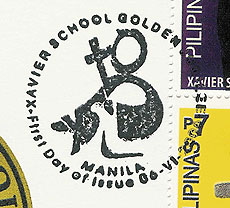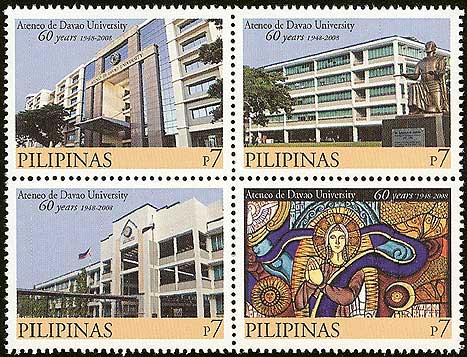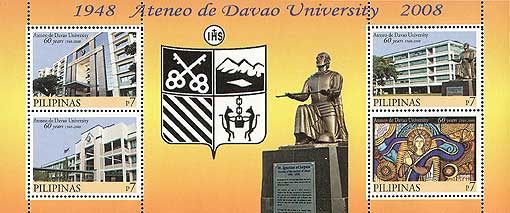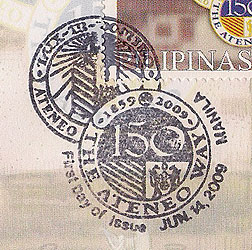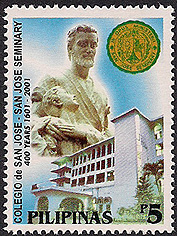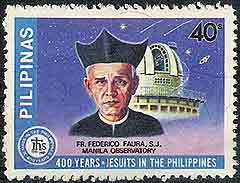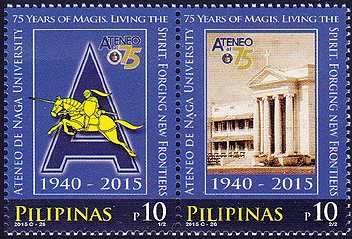Four Hundred Years



THE PHILIPPINES, 1981 and 1985, Scott 1537, 1737
a few of this second sheet have missing period after 3 and read P300
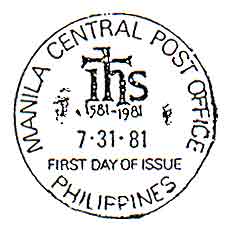
1981, FDI cancel for Scott 1537 above
The Philippine Islands marked 400 years since the first arrival of the Jesuits with a souvenir sheet (later surcharged) and four stamps. The Jesuits came to the Philippines in 1581, and were expelled after 187 years of work there; they returned to Manila in 1859.
Xavier University - Ateneo de Cagayan

THE PHILIPPINES, 1983, the 50th anniversary of the University, Scott 1647-48
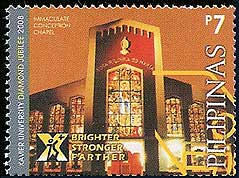

Note the name of Jesuit Teilhard de Chardin at the bottom of the list of scientists on the Science Center, 3166

THE PHILIPPINES, 2008, 75th anniversary of the University
featuring (a) the Immaculate Conception Chapel, (b) the statue of St. Francis Xavier,
(c) Archbishop Hayes, SJ, the founder, and (d) the Science Center
and the FDI cancel for the set
Xavier University was founded in 1933 as a high school named Ateneo de Cagayan by Jesuit missionary Fr. James T.G. Hayes SJ, but was destroyed during World War II. Reconstruction began immediately after the war; the College of Agriculture was started in 1953 by Fr. William Masterson, SJ, and the College of Law and the Manresa farm in 1955. In March 1958 the Ateneo de Cagayan received university status and the new name, Xavier University. Today Xavier University has a grade school with over 1,500 students, a high school with over 1,160, six undergraduate colleges with a total enrollment close to 9,000 (Arts and Sciences, Education, Commerce, Agriculture, Nursing, and Engineering), a Center for Industrial Technology for professional technician courses, and three professional schools (Law, Medicine and Graduate School), with a total enrollment of about 1219 students.
Sacred Heart School - Hijas de Jesus, Cebu City
THE PHILIPPINES, 50th anniversary of the school, Scott 3135
THE PHILIPPINES, 2007, 50th anniversary issue stamps and mini-sheet, Scott 3136While Sacred Heart School - Hijas de Jesus, formerly the Sacred Heart School for Girls, is not currently a Jesuit school, the Jesuit emblem on two of the above stamps and the repeated "Ad Majorem Dei Gloriam" motto indicate a Jesuit origin. The issue also shows Blessed Candida Maria of Jesus Cipitria, who based her spirituality on the Spiritual Exercises of Ignatius and founded the Hijas de Jesus with the help of Fr. Michael Herranz, SJ.
In 1953, the Cebu Chinese community asked Fr. Paul O’Brien, SJ, who was the Superior of the Jesuits' China Province Mission to establish a Chinese Catholic middle school. By 1954, the first 400 students started classes (K-6) under Jesuit educators Fr. Miguel Pardinas, Fr. Francisco Heras and Fr. Eugene Lauzon, in affiliation with the Colegio de San Jose Recoletos. By 1955, Sacred Heart School became an independent school, with separate boys’ and girls’ departments. In 1956 Fr. Heras, the rector, requested the Congregation of the Hijas de Jesus to send Sisters to oversee the Girls’ Department. Mother Superior Eloisa Alonso, FI and five companions arrived the same year and tended to the girls while the Jesuits tended to the boys on the same campus. By November 1957, the two schools split: the Hijas de Jesus Community transferred what was to be known as Sacred Heart School for Girls to its present location. In recent years both schools have become co-education, and the the names have been altered to Sacred Heart School - Jesuits, and Sacred Heart School - Hijas de Jesus. Sacred Heart School - Hijas de Jesus celebrated the Jubilee of this independent existence in 2007. Sacred Heart School - Jesuit celebrated its Jubilee in 2005.
St. James Church, Dapitan
PHILIPPINES, 1996, Historical Places in the Life of Riza: the Church of St. James in Dapitan, Scott 2450dThe Society of Jesus came to the Philippines in 1581. When the country was divided in 1598 among four religious congregations, the Jesuits were given the Diocese of Cebu which included Dapitan. At first, they were chaplains for the Spanish naval force, but in 1629, the Mexican Jesuit, Pedro Gutierez, was sent specifically to found the Dapitan mission. He established a permanent Jesuit residence there by 1671 and became its first superior. The Jesuits worked for the conversion of the Subanen, the original inhabitants of the peninsula, at times offering their lives as martyrs like Francisco Paliola 1648. Despite promising success, the Bourbon monarchs expelled them from Spanish lands in 1768 and from the Philippines shortly thereafter. Augustinian Recollects took over the Dapitan mission in 1770. The Royal Decree of 1852 allowed the Jesuits back. They returned to the Philippines, to their old Mindanao mission, and in 1870 to Dapitan. When it was established as a full fledged parish in 1896 Fr. Jose Vilaclara, spiritual advisor to the national hero Jose Rizal, was its first parish priest.
Dapitan is famous mostly for the four years which Rizal spent here in exile. Each Sunday he would attend Mass at the Church of St. James, which had been built by the Jesuits in 1883. Dapitan had been so harassed by pirates that the Jesuit missionaries chose James the Greater as their patron saint. James is said to have appeared during the legendary battle of Clavijo in 844, riding a white horse and brandishing a sword, to help the vastly outnumbered Christians beat the Islamic Moors led by the Emir of Cordoba. So it was hoped that he would help the people of Dapitan protect themselves from the Moro raiders. A statue of James astride a horse stands in the town square.
The Ateneo de Davao University
THE PHILIPPINES, 2008, the 60th anniversary of the University, Scott 3167
Three stamps feature the main school units of the school: (a) the facade of Finster Hall for the Jacinto campus, (b) the high school building facing Acacia Street, (c) the grade school building facing McArthur Highway, and (d) the fourth stamp features the stained glass window in the University Chapel of the Assumption of Our Lady, Patroness of the University. Finster Hall was named in memory of Fr. Paul Finster, SJ one of the pioneering educators assigned to Davao City and former president of Ateneo de Davao.
THE PHILIPPINES, 2008, souvenir sheet for the 60th anniversary of the UniversityThe Ateneo de Davao University is one of nine schools in the Philippines run by the Jesuits. Bishop Luis del Rosario SJ, Bishop of Zamboanga, in 1948 invited his Jesuit brothers to take over St. Peter's Parochial School and to found the Ateneo de Davao. Fr. Theodore E. Daigler, SJ was the first Rector of the school. The Ateneo de Davao at first offered Grades 5 and 6, and the first 3 years of high school on the Matina campus. The Jacinto campus was obtained in 1951. In 1953, the Ateneo de Davao College became co-educational, and by then 9 collegiate course programs were being offered. In 1961, the College of Law was started. In 1977 the College of Agriculture was started and the Ateneo de Davao gained University status; Fr. Emeterio Barcelon, SJ was it first University President.
La Inmaculada Concepcion Church, Guiuan, Eastern Samar
PHILIPPINES, 2012, from a block of four, part of a series of 8 heritage churches, Scott 3428aOn May 1, 2012 the Philippines honored eight Philippine Heritage Churches. One, La Inmaculada Concepcion Parish Church in Guiuan, Eastern Samar, was built by the Jesuits in the early 18th century and further decorated by the Franciscans in the 19th century, and the Parish Church of San Joaquin in Iloilo that was built in the 19th century by the Augustinians. La Inmaculada Concepcion Parish is the best preserved church complex in Samar-Leyte. The decoration of shells and coral throughout the church complex and especially in the baptistery is a tour-de-force and the only one of its kind in the country.
La Inmaculada Concepcion Church, Jasaan, Misamis Oriental
PHILIPPINES, 2012, from a souvenir sheet, part of a series of 8 heritage churches, Sctt 3429bThe Parish Church of La Inmaculada Concepcion, Jasaan, Misamis Oriental, about an hour from Cagayan de Oro City, was built in the late 19th century and early 20’s by the Jesuits. The Jesuit brothers Francisco Rivera and Juan Cuesta are credited with the construction of the original church. It is a "provincial" attempt at imitating San Ignacio Church in Manila. There are significant portions left of the original brick paving, neo-Geo ratablo and ceiling woodwork. The church was declared one of the National Historical Landmarks in the Philippines January 10, 1974 by the Philippine Government and the National Commission for Culture and the Arts (NCCA)

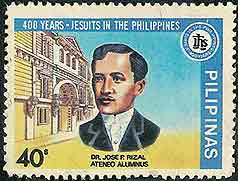
THE PHILIPPINES, 1961, the old Ateneo to the left, Scott 836
1981, Rizal in front of the Jesuit university, the Ateneo de Manila, Scott
1534


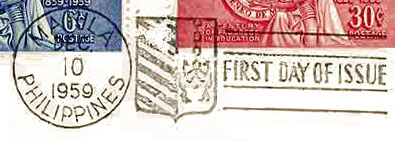
THE PHILIPPINES, 1959, the centenary of the Ateneo de Manila, Scott
810-811, and the FDI cancel
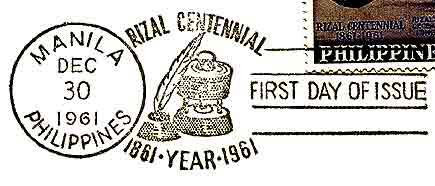
1961, FDI cancel for Scott 836 showing the Ateneo
de Manila
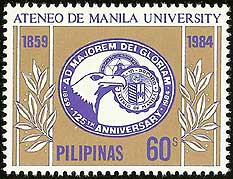

THE PHILIPPINES, 1984, the 125th anniversary of the Ateneo, Scott 1730-1731
When the Ateneo was recognized as a municipal institution it bore the municipal coat of arms to which the Jesuit monogram and a biblical motto "Lux in Domino" were added; when the municipality withdrew its support in 1901, a new coat of arms was devised. The above four stamps stamps show both.

PHILIPPINES, 2009, the 150th anniversary of the Ateneo de Manila with the FDI cancel, Scott 3223a-e

PHILIPPINES, 2009, the 70th anniversary of Quezon City
the Eagle Gym appears on the selvage in the lower left, Scott 3238eThe souvenir sheet for the 150th anniversary of the Ateneo shows many elements of the school: Fr. Horacio de la Costa, SJ; the old Manila Observatory at the original location of the school;the Blue Eagle Gym, the first structure on the new site at Loyola Heights: the Blue Eagle which is the mascot of the school; the Chapel of St. Stanislaus Kostka patron of the high school; a Statue of St. Ignatius, patron of the Ateneo, with his sword; the Church of the Gesu, the landmark church on campus; Dr. José Rizal, alumnus of the Ateneo and the National Hero of the Philippines:the Rockwell Campus in Makati City; Ateneo-Gawad-Kalinga (Housing for the Poor), the Ateneo's special social outreach program; the Ateneo Faculty and Staff; Fr. William Masterson, SJ, President of the Ateneo, who led its move in 1952 from Padre Faura, in Ermita, Manila to its present location in Loyola Heights; the Intramuros Manila Campus; the two seals of the Ateneo, and the Heroes Torch.
Although the first Jesuits arrived in the country in 1581, and founded one of the first colleges in the Philippines, the Colegio de Manila (also known as the Colegio Seminario de San Ignacio), their educational work was undone by their violent expulsion from all Spanish territories in 1768, and their Suppression in 1773. Pope Pius VII reinstated the Society in 1814, but the Jesuits would not return to the Philippines until 1859. Ten Spanish Jesuits arrived in Manila on April 14, 1859. They were sent mainly for missionary work in Mindanao and Jolo, but their reputation as educators remained entrenched in the minds of Manila’s leaders. In August th ecity council requested the Governor-General for a Jesuit school financed by public money. And in OCtober the Governor-General authorized the Jesuits to take over the Escuela Municipal, the only primary school in Manila at the time. Under the Jesuits, the Escuela eventually became the Ateneo Municipal de Manila in 1865, now an institution of secondary education. When American colonial rule came in 1902, the Ateneo lost its government subsidy, but in 1908, the colonial government recognized it as a college. American Jesuits took over administration in 1921.
The Ateneo de Manila High School
PHILIPPINES, 2010, the Jubilee of the Ateneo de Manila High School's Class of 1960, Scott 3341The High School is part of the general complex that includes the University above, and it shares the University's history. The stamps above show (a) the familiar seals of the Ateneo, and "Fabilioh" a traditional cheer unique to the Ateneo, that dates to the 1940s and 1950s, which means a lot of things if you are Ateneo-educated, but too much to relate here. (b) Themascot of the school is seen against the Church of the Gesu. "We stand on a hill..." is the anthem of the school. (c) And the White and Blue, the colors of Mary, are the its colors. The statue is of Mary, the Patroness of the Ateneo. (d) Members of Ateneo High School Class of 1960, along with some others, donated the carillon at the Church of the Gesu in 2004 in the ruby celebration of their college graduation, and now on their golden jubilee have added more bells to fill up missing notes. Hence, the moniker The Bell Ringers of the Gesu.
Colegio de San Ildefonso, Manila
SPAIN, 1988, this Europa issue shows the Plaza of Manila and specifically
the Seminario Real de San Carlos on the right side, earlier called the Colegio de San Ildefonso, Scott 2556On 21 August 1595 the Jesuits established the Colegio de San Ildefonso attached to their residence in Cebu. Although not specifically for the training of priests, the school provided an ideal place for native young boys to develop good character traits and learn the basics of the newly-planted Christian faith. The school officially closed on June 1, 1769 when King Charles III ordered the expulsion of the Jesuits from all Spanish territory.
In 1777 the Bishop of Cebu, Mateo Joaquin Rubio de Arevalo, petitioned King Charles III for the land and building of the closed Colegio to use it as a seminary. The King granted the request in 1779 and decreed the founding of a diocesan seminary to be called Real Seminario de San Carlos. In 1867 the seminary officially admitted extern students, and this led eventually into a separation into the Seminario Mayor de San Carlos and The University of San Carlos.
San Jose College and Seminary, Manila
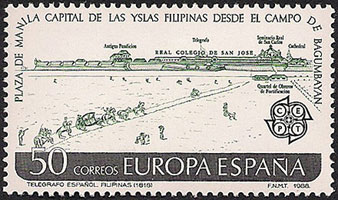
SPAIN, 1988, this stamp shows the Real Colegio de San Jose to the left of the Seminario Real de San Carlos, Scott 2556
PHILIPPINES, 2001, 4th centenary of the Colegio de San Jose, Scott 2744The Jesuits also opened the Colegio de Manila, the first institution of higher learning in the Philippines and the predecessor of Colegio de San Jose. In 1601 Fr. Pedro Chirino, rector of the Colegio de Manila, began to organize the Colegio de San Jose which opened on August 1st of that year. In 1722 King Philip V of Spain conferred upon the Colegio de San Jose the title "royal" making it El Real Colegio de San Jose. In 1768 orders arrived in Manila, issued the previous year by King Carlos III of Spain, ordering the expulsion of the Jesuits from all Spanish territories and the confiscation of their possessions. The Colegio de San Jose continued to function under the secular clergy. During the American Occupation of the Philippines, the United States inherited from the Spanish Crown all government assets in the islands, including the administration of the Colegio de San Jose estate. And in 1907, through the Taft-Harty Agreement, it was agreed that the school should fall entirely under church jurisdiction with no claims from the government. A Brief of Pope Pius X dated May 3, 1910, returned the school to the Jesuits. On June 15, 1915 the Colegio de San Jose once more opened as a seminary for the training of the secular clergy in the Philippines. In the 1930s the institution became known as San Jose Seminary. After several moves the Seminary was transferred in 1964 to its present location in Loyola Heights, where in 2001 it celebrated its fourth centenary, honored by the Philippine government with the issue of a stamp.
The Manila Observatory



